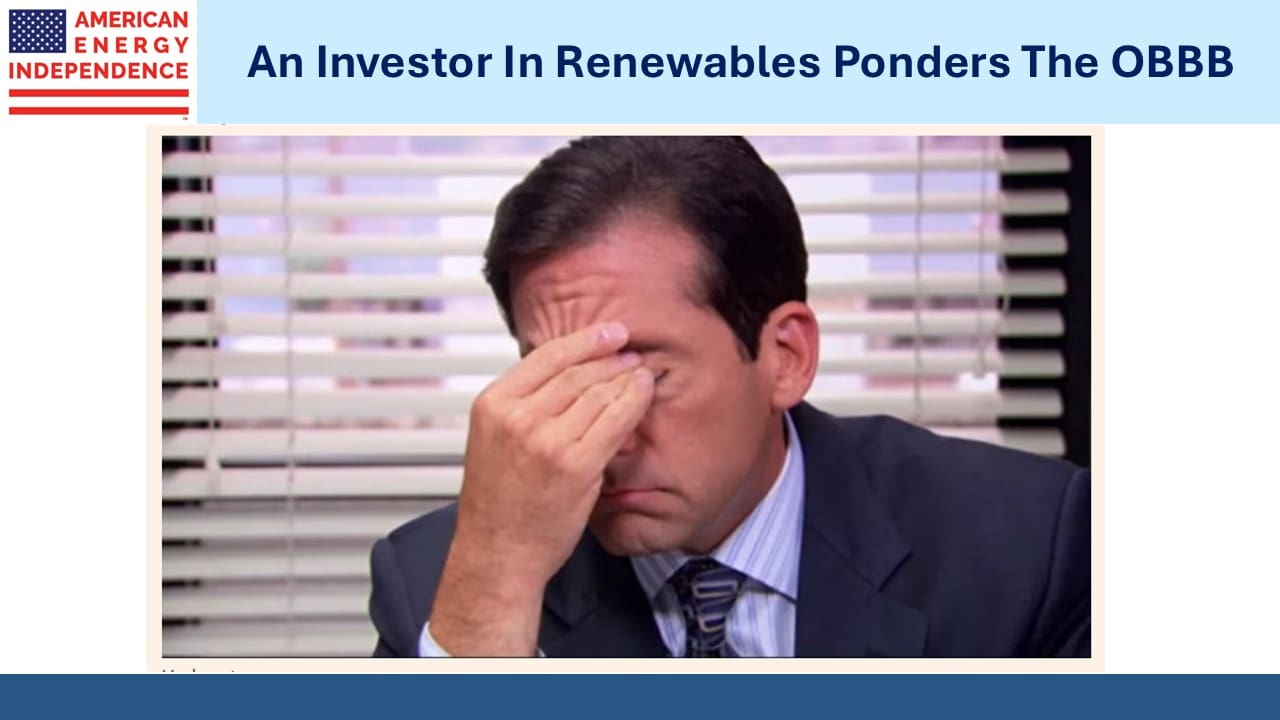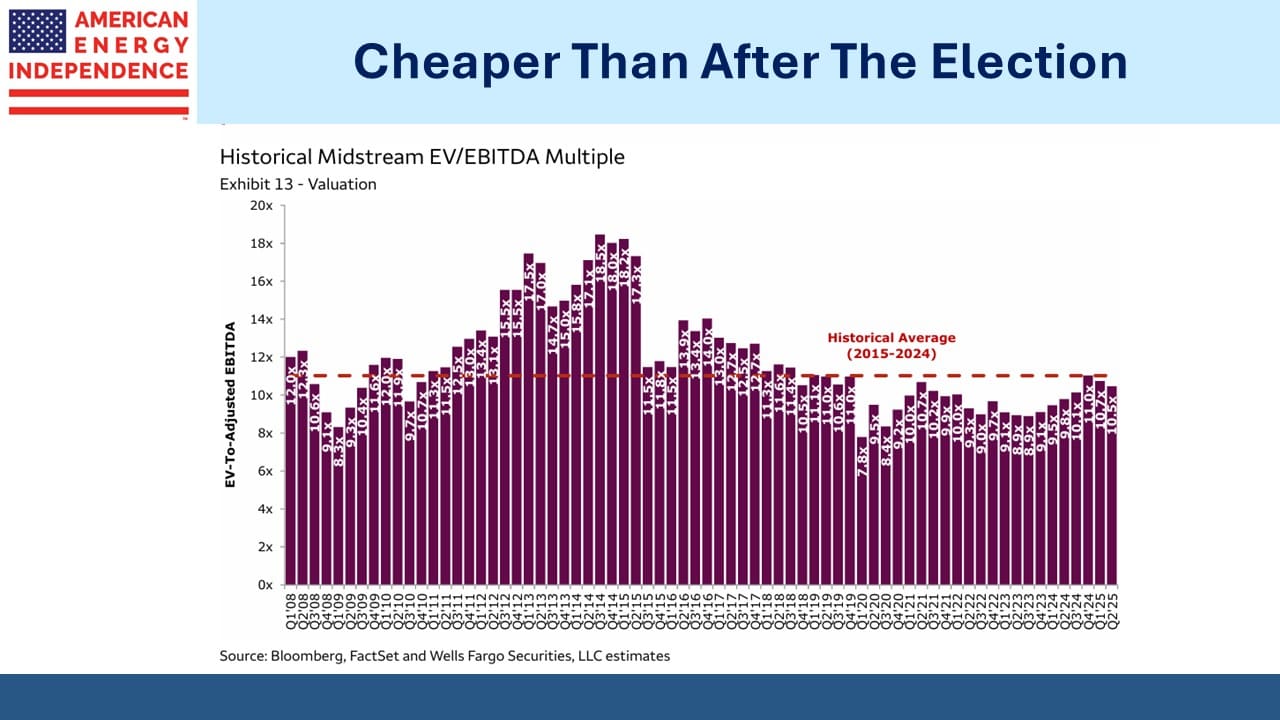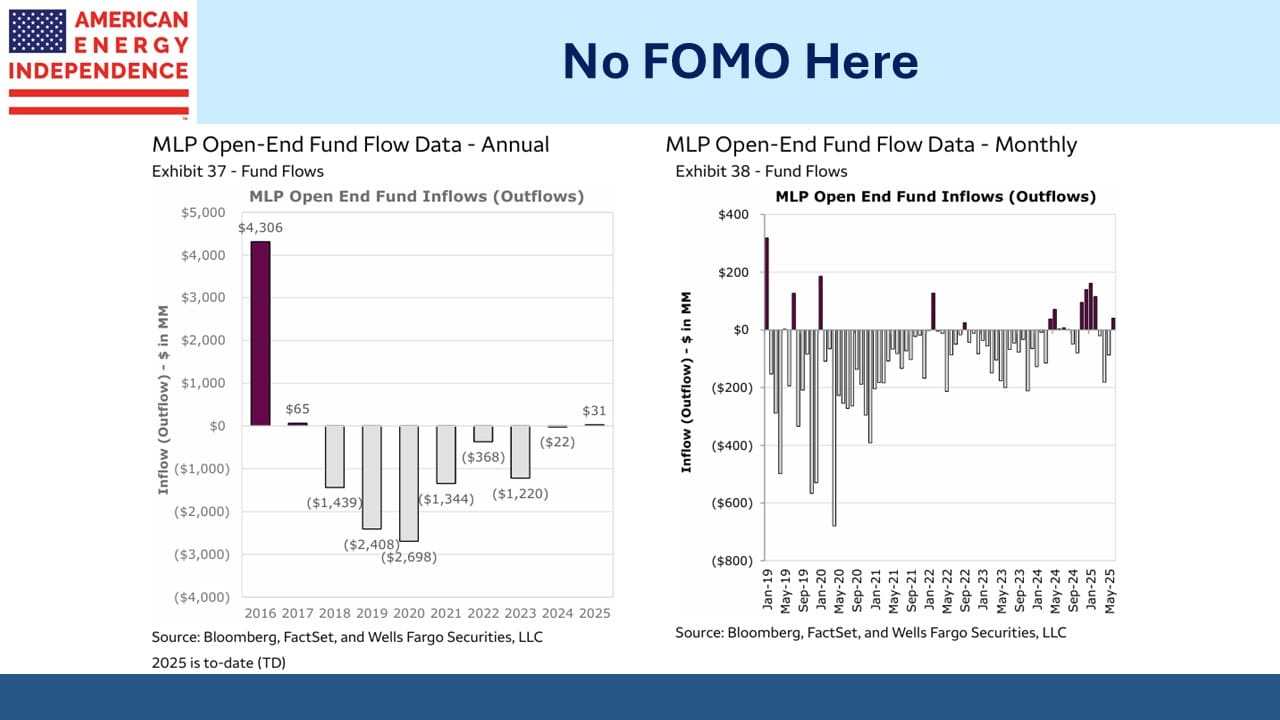Reliable Energy Is Mainstream Again

/
The ending of many renewables subsidies in the One Big Beautiful Bill (OBBB) is being hailed as a win for the oil and gas industry. The WSJ wrote, The Moment the Clean-Energy Boom Ran Into ‘Drill, Baby, Drill’, suggesting that oil production will benefit.
But in reality it’s about electricity generation, and oil produced just 0.4% last year. It’s an expensive way to generate power – globally it was just 2.2%. Oil is used as a back-up in places like Boston where new natural gas pipelines have been opposed, although this may be changing (see Gas Kept Us Cool Last Week).
Saudi Arabia gets over a third of their electricity from oil, since they have it in abundance. They use natural gas for the rest.
Since renewables are all about power generation and OBBB shifted public policy support away from them, natural gas is the obvious winner. With EV sales faltering, crude oil demand may also benefit but not as much as gas.
The change in priorities reflects evolving public opinion. A majority still favors expanding solar and wind output, but according to one survey that has fallen to 60% from 79% five years ago. Unsurprisingly, red and blue respondents hold widely differing views.
The shift back towards reliable hydrocarbons isn’t limited to America. Canada’s PM Mark Carney recently said it’s, “highly likely that we will have an oil pipeline…” when asked about improving access of Alberta’s crude oil to foreign markets by adding a pipeline to Canada’s Pacific coast.
Alberta may be the only Canadian province where Trump’s disappointing references to the 51st state don’t provoke widespread anger. Carney likely believes that supporting Alberta’s energy sector will snuff out any nascent calls for secession, and the country badly needs alternative export routes for its hydrocarbons. Canadians know they’re too reliant on their southern neighbor.
Canada shipped its first tanker full of LNG last week, from Kitimat, BC. The export terminal, owned by LNG Canada, cost about C$48BN ($35BN). PM Carney said, “Canada has what the world needs.” He wants to lead “the world’s leading energy superpower.”
Until recently Canada thought of itself as a leader in reducing greenhouse gas emissions, even though their per capita emissions are among the world’s highest at 20.4 tonnes per year (the US is 17.2). They attribute this to their energy intensive industries, ironically including oil and gas extraction, and their cold climate.
The Department of Energy (DoE) just released a report evaluating grid reliability. Demand is rising at a faster rate than in the past, mainly because of data centers. The supply mix is becoming less reliable as dispatchable power from coal plants is replaced with intermittent solar and wind.
Some may find the report’s tone political, such as this sentence: The current administration has made great strides—such as deregulation, permitting reform, and other measures—to enable addition of more energy infrastructure…
But then NJ residents just saw electricity bills rise 17% which their grid operator PJM blamed on the same factors mentioned in the DoE report: data centers and insufficient new dispatchable power, which really means reliable power that’s there when needed.
The whole situation needs more natural gas power plants.
So far this year, midstream energy infrastructure is +3.5%, lagging the S&P500 by around 3%. Operating performance has remained strong, resulting in cheaper valuations for those still inadequately allocated to the sector.
Consequently, EV/EBITDA has slipped from the ten year average of 11.0X at the end of last year to 10.5X now. Dividend yields of around 4.5%, added to dividend growth of 3-4% and buybacks of 2-3% imply a prospective total return of around 10% pa (ie 4.5% + 3.5% + 2.5%). A return to 11.0 EV/EBITDA would mean a 4.76% increase in enterprise value (i.e. 0.5/10.5 = 0.0476) which given the prevailing 50/50 split between debt and equity liabilities would result in a 9-10% price increase (4.76% X 2).
In other words, pipelines are cheaper than they were following the election. White House policies have been at least as supportive towards traditional energy as was hoped eight months ago. The fundamentals support appreciation from current levels.
Retail investors remain cautious after a spurt of buying earlier in the year. Open-ended MLP funds, which confusingly includes c-corps which are now the dominant corporate form, have seen minor net inflows this year after seven straight years of outflows. This should soothe the fears of any potential buyer that it’s a hot sector. Sentiment is at odds with valuations, as is often the case.
We’re happy to report that net inflows to products managed by your blogger and partner Henry here at SL Advisors are well in excess of the $31million net adds to the sector.
We have two have funds that seek to profit from this environment:

Important Disclosures
The information provided is for informational purposes only and investors should determine for themselves whether a particular service, security or product is suitable for their investment needs. The information contained herein is not complete, may not be current, is subject to change, and is subject to, and qualified in its entirety by, the more complete disclosures, risk factors and other terms that are contained in the disclosure, prospectus, and offering. Certain information herein has been obtained from third party sources and, although believed to be reliable, has not been independently verified and its accuracy or completeness cannot be guaranteed. No representation is made with respect to the accuracy, completeness or timeliness of this information. Nothing provided on this site constitutes tax advice. Individuals should seek the advice of their own tax advisor for specific information regarding tax consequences of investments. Investments in securities entail risk and are not suitable for all investors. This site is not a recommendation nor an offer to sell (or solicitation of an offer to buy) securities in the United States or in any other jurisdiction.
References to indexes and benchmarks are hypothetical illustrations of aggregate returns and do not reflect the performance of any actual investment. Investors cannot invest in an index and do not reflect the deduction of the advisor’s fees or other trading expenses. There can be no assurance that current investments will be profitable. Actual realized returns will depend on, among other factors, the value of assets and market conditions at the time of disposition, any related transaction costs, and the timing of the purchase. Indexes and benchmarks may not directly correlate or only partially relate to portfolios managed by SL Advisors as they have different underlying investments and may use different strategies or have different objectives than portfolios managed by SL Advisors (e.g. The Alerian index is a group MLP securities in the oil and gas industries. Portfolios may not include the same investments that are included in the Alerian Index. The S & P Index does not directly relate to investment strategies managed by SL Advisers.)
This site may contain forward-looking statements relating to the objectives, opportunities, and the future performance of the U.S. market generally. Forward-looking statements may be identified by the use of such words as; “believe,” “expect,” “anticipate,” “should,” “planned,” “estimated,” “potential” and other similar terms. Examples of forward-looking statements include, but are not limited to, estimates with respect to financial condition, results of operations, and success or lack of success of any particular investment strategy. All are subject to various factors, including, but not limited to general and local economic conditions, changing levels of competition within certain industries and markets, changes in interest rates, changes in legislation or regulation, and other economic, competitive, governmental, regulatory and technological factors affecting a portfolio’s operations that could cause actual results to differ materially from projected results. Such statements are forward-looking in nature and involves a number of known and unknown risks, uncertainties and other factors, and accordingly, actual results may differ materially from those reflected or contemplated in such forward-looking statements. Prospective investors are cautioned not to place undue reliance on any forward-looking statements or examples. None of SL Advisors LLC or any of its affiliates or principals nor any other individual or entity assumes any obligation to update any forward-looking statements as a result of new information, subsequent events or any other circumstances. All statements made herein speak only as of the date that they were made. r
Certain hyperlinks or referenced websites on the Site, if any, are for your convenience and forward you to third parties’ websites, which generally are recognized by their top level domain name. Any descriptions of, references to, or links to other products, publications or services does not constitute an endorsement, authorization, sponsorship by or affiliation with SL Advisors LLC with respect to any linked site or its sponsor, unless expressly stated by SL Advisors LLC. Any such information, products or sites have not necessarily been reviewed by SL Advisors LLC and are provided or maintained by third parties over whom SL Advisors LLC exercise no control. SL Advisors LLC expressly disclaim any responsibility for the content, the accuracy of the information, and/or quality of products or services provided by or advertised on these third-party sites.
All investment strategies have the potential for profit or loss. Different types of investments involve varying degrees of risk, and there can be no assurance that any specific investment will be suitable or profitable for a client’s investment portfolio.
Past performance of the American Energy Independence Index is not indicative of future returns.





Doomberg’s interview on Thoughtful Money well worth one’s time.
https://www.youtube.com/watch?v=tO6NAwyWRK8
MLPs produce better yields with their tax deferred unit distributions than do C corporations with their dividends.